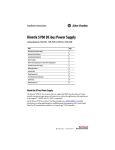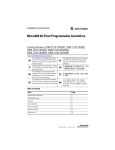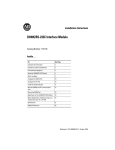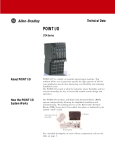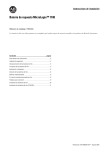Download Allen-Bradley SLC 500 1747-L541 Specifications
Transcript
Installation Instructions SLC 5/03, SLC 5/04, and SLC 5/05 Modular Processors Catalog Numbers 1747-L531, 1747-L532, 1747-L533, 1747-L541, 1747-L542, 1747-L543, 1747-L551, 1747-L552, 1747-L553 http://literature.rockwellautomation.com/idc/groups/literature/documents/in/1 747-in009_-mu-p.pdf FR Cette publication est disponible en français sous forme électronique (fichier PDF). Pour la télécharger, rendez-vous sur la page Internet indiquée ci-dessus. IT Questa pubblicazione è disponibile in Italiano in formato PDF. Per scaricarla collegarsi al sito Web indicato sopra. DE Diese Publikation ist als PDF auf Deutsch verfügbar. Gehen Sie auf die oben genannte Web-Adresse, um nach der Publikation zu suchen und sie herunterzuladen. ES Esta publicación está disponible en español como PDF. Diríjase a la dirección web indicada arriba para buscar y descarga esta publicación. PT Esta publicação está disponível em portugués como PDF. Vá ao endereço web que aparece acima para encontrar e fazer download da publicação. Publication 1747-IN009B-EN-P - March 2008 2 Publication 1747-IN009B-EN-P - March 2008 Installation Instructions SLC 5/03, SLC 5/04, and SLC 5/05 Modular Processors Catalog Numbers 1747-L531, 1747-L532, 1747-L533 1747-L541, 1747-L542, 1747-L543, 1747-L551, 1747-L552, 1747-L553 Topic Page Safety Considerations 5 Hazardous Location Considerations 5 Required Tools and Equipment 7 Install the SLC Processor 7 Apply Power to the Processor 8 Loading Your Software 9 Establish Communication to the Processor 9 Replace the Battery 10 Troubleshooting Your SLC Processor 12 Specifications 12 Communication 13 Memory Backup 14 Battery Handling, Storing, and Transporting (Cat. No. 1747-BA) 14 Additional Resources 16 Publication 1747-IN009B-EN-P - March 2008 4 SLC 5/03, SLC 5/04, and SLC 5/05 Modular Processors Important User Information Solid state equipment has operational characteristics differing from those of electromechanical equipment. Safety Guidelines for the Application, Installation and Maintenance of Solid State Controls (publication SGI-1.1 available from your local Rockwell Automation sales office or online at http://literature.rockwellautomation.com) describes some important differences between solid state equipment and hard-wired electromechanical devices. Because of this difference, and also because of the wide variety of uses for solid state equipment, all persons responsible for applying this equipment must satisfy themselves that each intended application of this equipment is acceptable. In no event will Rockwell Automation, Inc. be responsible or liable for indirect or consequential damages resulting from the use or application of this equipment. The examples and diagrams in this manual are included solely for illustrative purposes. Because of the many variables and requirements associated with any particular installation, Rockwell Automation, Inc. cannot assume responsibility or liability for actual use based on the examples and diagrams. No patent liability is assumed by Rockwell Automation, Inc. with respect to use of information, circuits, equipment, or software described in this manual. Reproduction of the contents of this manual, in whole or in part, without written permission of Rockwell Automation, Inc., is prohibited. Throughout this manual, when necessary, we use notes to make you aware of safety considerations. WARNING IMPORTANT ATTENTION Identifies information about practices or circumstances that can cause an explosion in a hazardous environment, which may lead to personal injury or death, property damage, or economic loss. Identifies information that is critical for successful application and understanding of the product. Identifies information about practices or circumstances that can lead to personal injury or death, property damage, or economic loss. Attentions help you to identify a hazard, avoid a hazard, and recognize the consequences. SHOCK HAZARD Labels may be on or inside the equipment, for example, a drive or motor, to alert people that dangerous voltage may be present. BURN HAZARD Labels may be on or inside the equipment, for example, a drive or motor, to alert people that surfaces may reach dangerous temperatures. Publication 1747-IN009B-EN-P - March 2008 SLC 5/03, SLC 5/04, and SLC 5/05 Modular Processors 5 Safety Considerations ATTENTION Never install, remove, or wire any module while power is applied. Also, do not expose processor modules to surfaces or other areas that may typically hold an electrostatic charge. Electrostatic charges can alter or destroy memory. For general recommendations concerning installation safety requirements and safety related work practices, refer to the requirements specific to your region. • Europe: Reference the standards found in EN 60204 and your national regulations. • United States: refer to NFPA 70E, Electrical Safety Requirements for Employee Workplaces. IMPORTANT See page 14 for information on proper battery handling, storage, and transporting. Hazardous Location Considerations This equipment is suitable for use in Class I, Division 2, Groups A, B, C, D or non-hazardous locations only. The following WARNING statement applies to use in hazardous locations. WARNING EXPLOSION HAZARD • Substitution of components may impair suitability for Class I, Division 2. • Do not replace components or disconnect equipment unless power has been switched off or the area is known to be non-hazardous. • Do not connect or disconnect components unless power has been switched off or the area is known to be non-hazardous. • This product must be installed in an enclosure. All cables connected to the product must remain in the enclosure or be protected by conduit or other means. • All wiring must comply with N.E.C. article 501-4(b). Publication 1747-IN009B-EN-P - March 2008 6 SLC 5/03, SLC 5/04, and SLC 5/05 Modular Processors Environnements dangereux Cet équipement est adapté à une utilisation en environnements de Classe I, Division 2, Groupes A, B, C, D ou dans des environnements non dangereux. La mise en garde suivante porte sur une utilisation en environnement dangereux. AVERTISSEMENT DANGER D'EXPLOSION • La substitution de composants peut rendre cet équipement impropre à une utilisation en environnement de Classe I, Division 2. • Ne pas remplacer de composants ou déconnecter l'équipement sans s'être assuré que l'alimentation est coupée et que l'environnement est classé non dangereux. • Ne pas connecter ou déconnecter des composants sans s'être assuré que l'alimentation est coupée et que l'environnement est classé non dangereux. • Ce produit doit être installé dans une armoire. Tous les câbles qui lui sont connectés doivent rester dans l’armoire ou être protégés par un conduit ou par d’autres moyens. • L'ensemble du câblage doit être conforme aux normes d'électricité en vigueur dans le pays où l'appareil est utilisé. Publication 1747-IN009B-EN-P - March 2008 SLC 5/03, SLC 5/04, and SLC 5/05 Modular Processors 7 Required Tools and Equipment • medium blade screwdriver • programming equipment • appropriate network interface or cable Cable Requirements Network Interface Processor SLC 5/03 1747-UIC (1) X SLC 5/04 SLC 5/05 X(4) X(4) X 1747-PIC X 1747-CP3 X X 1784-PKTX(D) X(2) X 1784-PCMK X(3) X(5) 10/100Base-T Ethernet (1) (2) (3) (4) (5) X requires 1747-C13 or 1747-CP3 cable requires 1784-CP14 cable requires 1784-PCM4 cable requires 1747-CP3 cable requires 1784-PCM6 cable Install the SLC Processor Make sure system power is off; then insert the processor into slot 0 of the 1746 chassis. IMPORTANT The SLC 500 modular processors must be inserted into the left slot (slot 0). Inserting the processor in another slot won’t allow the processor to operate. In addition, remove the protective wrap after installing the processor. Failure to remove the wrap can cause the power supply to overheat. Publication 1747-IN009B-EN-P - March 2008 8 SLC 5/03, SLC 5/04, and SLC 5/05 Modular Processors Power Supply Processor Release Card Guide Protective Wrap Apply Power to the Processor 1. Energize the chassis power supply. 2. Check the chassis power supply and processor LED indicators. The power LED indicator on the power supply should be on and the fault LED indicator on the processor should be flashing. See the figure on page 9 for location of the power supply and processor LED indicators. Publication 1747-IN009B-EN-P - March 2008 SLC 5/03, SLC 5/04, and SLC 5/05 Modular Processors 9 Power Supply and LED Indicators Indicates the LED indicator is OFF. POWER RUN FORCE FLT DH485 BATT RS232 Indicates the LED indicator is ON. Indicates the LED indicator is FLASHING. Status of LED indicator does not matter. SLC 5/03 POWER RUN FLT BATT FORCE POWER RUN FLT DH+ BATT RS232 FORCE ENET RS232 SLC 5/05 SLC 5/04 Loading Your Software Refer to your programming software documentation. Establish Communication to the Processor 1. Refer to the following table to establish communication between the processor and your personal computer. Processor Procedure SLC 5/03 Connect the 1747-PIC interface from the processor to your personal computer serial port or connect the 1747-UIC interface from the processor to your personal computer USB port to the processor using the 1747-C13 or 1747-CP3 cable. You can also use a 1784-PKTX(D) or 1784-PCMK interface, or a 1747-CP3 cable from channel 0 of the processor to the personal computer serial port. SLC 5/04 Connect a 1747-CP3 cable from channel 0 of the processor to the personal computer serial port or connect the 1747-UIC interface from channel 0 of the processor to your personal computer USB port, or use a 1784-PKTX(D) or 1784-PCMK interface. SLC 5/05 Connect a 1747-CP3 cable from channel 0 of the processor to the personal computer serial port, or connect the 1747-UIC interface converter from channel 0 of the processor to your personal computer USB port. For Ethernet connection, connect channel 1 of the processor and the PC Ethernet Card to an Ethernet hub using 10/100Base-T compatible cable.(1) (1) EtherNet/IP address must first be set via BOOTP or an RS-232 connection. Publication 1747-IN009B-EN-P - March 2008 10 SLC 5/03, SLC 5/04, and SLC 5/05 Modular Processors 2. Set the communication parameters of the software to match the default parameters of the processor. Channel 0 Configuration Channel 1 Configuration SLC 5/03, 5/04, 5/05 SLC 5/03 SLC 5/04 SLC 5/05 DF1 Full-duplex: DH-485: DH+: Ethernet: • no handshaking • 19.2 Kbaud • 19.2 Kbaud • node address = 1 • 57.6 Kbaud BOOTP enabled • node address = 1 • CRC Error Check • duplicate detect on • no parity Replace the Battery Your SLC processor provides back-up power for RAM through a replaceable lithium battery. This battery provides back-up for approximately 2 years. The BATT LED indicator on the front of the processor alerts you when the battery voltage has fallen below a threshold level. To replace the lithium battery follow these steps. ATTENTION Do not remove the processor from the SLC 500 chassis until all power is removed from the SLC 500 power supply. If you remove the power supply while power is applied, an electrical arc can occur. This could cause an explosion in hazardous location installations. 1. Remove power from the SLC 500 power supply. 2. Remove the processor from the chassis by pressing the retainer clips at both the top and bottom of the module and slide it out. ATTENTION Do not expose the processor to surfaces or other areas that may typically hold an electrostatic charge. Electrostatic charges can alter or destroy memory. Publication 1747-IN009B-EN-P - March 2008 SLC 5/03, SLC 5/04, and SLC 5/05 Modular Processors 11 3. Unplug the battery connector. Battery Red White Battery Connector Left Side View IMPORTANT The SLC 5/03, 5/04, and 5/05 processors have a capacitor that provides at least 30 minutes of battery back-up while the battery is disconnected. Data in RAM is not lost if the battery is replaced within 30 minutes. 4. Remove the battery from the retaining clips. 5. Insert a new battery into the battery retaining clips. 6. Plug the battery connector into the socket as shown above. 7. Re-insert the module into the SLC 500 chassis. 8. Restore power to the SLC 500 power supply. 9. Close the processor door. IMPORTANT See page 14 for information on proper battery handling, storage, and transporting. Publication 1747-IN009B-EN-P - March 2008 12 SLC 5/03, SLC 5/04, and SLC 5/05 Modular Processors Troubleshooting Your SLC Processor Before troubleshooting your SLC 500 system, please obtain an SLC 500 Modular Hardware Style User Manual, publication 1747-UM011. Refer to the chapter on troubleshooting. In addition to the SLC 500 Modular Hardware Style User Manual, publication 1747-UM011, the SLC 500 Instruction Set Reference Manual, publication 1747-RM001, contains explanations and examples for the entire instruction set as well as for all status words and bits. It also contains explanations for all possible fault codes found in status word S:6. Specifications SLC 5/03, SLC 5/04, and SLC 5/05 Processors Attribute SLC 5/03 L531 Memory (words) 8 K SLC 5/04 L532 L533 L541 L542 L543 L551 L552 L553 16 K 32 K 16 K 32 K 64 K 16 K 32 K 64 K I/O capacity, max 4096 discrete inputs/4096 discrete outputs Local system, max 3 chassis / 30 slots Programming instructions 107 Typical scan time(1) 1 ms/K 0.9 ms/K Bit execution (XIC) 0.44 µs 0.37 µs Programming software SLC 5/03s and SLC 5/04s: RSLogix 500, SLC 5/05s: RSLogix 500 (1) SLC 5/05 The scan times are typical for a 1 K ladder logic program consisting of simple ladder logic and communication servicing. Actual scan times depend on your program size, instructions used, and the communication protocol. Publication 1747-IN009B-EN-P - March 2008 SLC 5/03, SLC 5/04, and SLC 5/05 Modular Processors 13 Specifications Attribute Value Power supply loading at 5V dc 500 mA for the SLC 5/03 processor 1.0 A for the SLC 5/04 and 5/05 processors Power supply loading at 24V dc 175 mA for the SLC 5/03 processor 0 mA for the SLC 5/04 processor (1) 0 mA for the SLC 5/05 processor Program scan hold-up time after loss of power 20 ms...3 s (dependent on power supply loading) Noise immunity NEMA Standard ICS 2-230 Vibration Displacement: 0.015 in., peak-to-peak at 5-57 Hz Acceleration: 2.5 g at 57...2000 Hz Shock, operating 30 g Ambient temperature rating, operating 0...60 °C (32...140 °F) Ambient temperature rating, storage -40...85 °C (-40...185 °F) Humidity 5 to 95% without condensation Agency certification See http://ab.com for declarations of conformity, certificates, and other certification details. UL Listed Industrial Control Equipment C-UL Listed Industrial Control Equipment for use in Canada UL Listed Industrial Control Equipment for use in Class I, Division 2, Hazardous Locations Groups A, B, C or D CE compliant for all applicable directives C-Tick marked for all applicable acts (1) SLC 5/04 Processors manufactured prior to April 2002 draw 200 mA at 24V dc. Check your label to verify your processor’s current draw. Communication Communication options for the SLC 5/03, 5/04, and 5/05 processors are as follows: • DH485 • RS-232 protocols (DF1 Full-duplex, DF1 Half-duplex master/slave, DF1 Radio Modem, DH-485, or ASCII) • Data Highway Plus (A ControlLogix Gateway is required for the SLC 5/03 and SLC 5/05 processors.) • Ethernet TCP/IP (A 1761-NET-ENI interface module is required for the SLC 5/03 and SLC 5/04 processors) • ControlNet (via a 1747-KFC15 module) • DeviceNet (via a 1761-NET-DNI interface module) Publication 1747-IN009B-EN-P - March 2008 14 SLC 5/03, SLC 5/04, and SLC 5/05 Modular Processors Memory Backup The following table shows the memory backup options for the SLC 5/03, 5/04, and 5/05 processors. Flash EPROMs (Flash Erasable Programmable Read Only Memory) combine the versatility of EEPROMs (Electrically-Erasable Programmable Read Only Memory) with the security of UVPROMs (UV-Erasable PROM). Memory Backup Option SLC 5/03 Processor (1747-L531, 1747-L532, 1747-L533) SLC 5/04 Processor (1747-L541, 1747-542, 1747-543) SLC 5/05 Processor (1747-L551, 1747-552, 1747-553) Flash EPROM 1747-M13 (OS302 Series C or later) 1747-M13 (OS401 Series C or later) 1747-M13 (OS501 Series C or later) Battery Handling, Storing, and Transporting (Cat. No. 1747-BA) Handling ATTENTION Do not charge the batteries. An explosion could result or the cells could overheat causing burns. Do not open, puncture, crush, or otherwise mutilate the batteries. An explosion may result and/or toxic, corrosive, and flammable liquids would be exposed. Storing Store the lithium batteries in a cool, dry environment, typically 20...25 °C (68...77 °F) and 40% to 60% relative humidity. Transporting One or Two Batteries - Up to two batteries can be shipped together within the United States without restriction. Regulations governing shipment to or within other countries may differ. Three or More Batteries - Procedures for the transportation of three or more batteries shipped together within the United States are specified by the Department of Transportation (DOT) in the Code of Federal Regulations, CFR49, “Transportation.” An exemption to these regulations, DOT - E7052, covers the transport of certain hazardous materials classified as flammable solids. This exemption authorizes transport of lithium batteries by motor vehicle, rail freight, cargo vessel, and cargo-only aircraft, providing certain conditions are met. Transport by passenger aircraft is not permitted. Publication 1747-IN009B-EN-P - March 2008 SLC 5/03, SLC 5/04, and SLC 5/05 Modular Processors 15 Shipment of depleted batteries for disposal may be subject to specific regulation of the countries involved or to regulations endorsed by those countries, such as the IATA Restricted Articles Regulations of the International Air Transport Association, Geneva, Switzerland. IMPORTANT Regulations for transportation of lithium batteries are periodically revised. Refer to http://www.dot.gov for the latest shipping information. ATTENTION Do not incinerate or dispose of lithium batteries in general trash collection. Explosion or violent rupture is possible. Batteries should be collected for disposal in a manner to prevent against short circuiting, compacting, or destruction of case integrity and hermetic seal. For disposal, batteries must be packaged and shipped in accordance with transportation regulations, to a proper disposal site. The U.S. Department of Transportation authorizes shipment of “Lithium batteries for disposal” by motor vehicle only in regulation 173.1015 of CFR 49 (effective January 5, 1983). For additional information contact: U.S. Department of Transportation Research and Special Programs Administration 400 Seventh Street, S.W. Washington, D.C. 20590 Although the Environmental Protection Agency at this time has no regulations specific to lithium batteries, the material contained may be considered toxic, reactive, or corrosive. The person disposing of the material is responsible for any hazard created in doing so. State and local regulations may exist regarding the disposal of these materials. For a lithium battery material safety data sheet, contact the manufacturer. Sanyo Energy Corporation Tadarand U.S. Battery Division or 600 Supreme Drive 2 Seaview Blvd. Bensenville, IL 60106 Port Washington, NY 11050 USA USA Publication 1747-IN009B-EN-P - March 2008 16 Additional Resources Resource Description SLC 500 Modular Hardware Style User Manual, publication 1747-UM011 A more detailed description on how to install and use your modular SLC 500 system. SLC 500 Instruction Set Reference Manual, publication 1747-RM001 A reference manual that contains status file data, instruction set, and troubleshooting information. You can view or download publications at http://literature.rockwellautomation.com. To order paper copies of technical documentation, contact your local Rockwell Automation distributor or sales representative. Publication 1747-IN009B-EN-P - March 2008 17 Notes: Publication 1747-IN009B-EN-P - March 2008 18 Notes: Publication 1747-IN009B-EN-P - March 2008 19 Notes: Publication 1747-IN009B-EN-P - March 2008 Rockwell Automation Support Rockwell Automation provides technical information on the Web to assist you in using its products. At http://support.rockwellautomation.com, you can find technical manuals, a knowledge base of FAQs, technical and application notes, sample code and links to software service packs, and a MySupport feature that you can customize to make the best use of these tools. For an additional level of technical phone support for installation, configuration, and troubleshooting, we offer TechConnect Support programs. For more information, contact your local distributor or Rockwell Automation representative, or visit http://support.rockwellautomation.com. Installation Assistance If you experience a problem with a hardware module within the first 24 hours of installation, please review the information that's contained in this manual. You can also contact a special Customer Support number for initial help in getting your module up and running. United States 1.440.646.3434 Monday – Friday, 8am – 5pm EST Outside United States Please contact your local Rockwell Automation representative for any technical support issues. New Product Satisfaction Return Rockwell tests all of its products to ensure that they are fully operational when shipped from the manufacturing facility. However, if your product is not functioning, it may need to be returned. United States Contact your distributor. You must provide a Customer Support case number (see phone number above to obtain one) to your distributor in order to complete the return process. Outside United States Please contact your local Rockwell Automation representative for return procedure. Allen-Bradley, Rockwell Automation, TechConnect, SLC, SLC 5/03, Data Highway Plus, DH+, RSLogix 500, and SLC 500 are trademarks of Rockwell Automation, Inc. Trademarks not belonging to Rockwell Automation are the property of their respective companies. Publication 1747-IN009B-EN-P - March 2008 Supersedes Publication 1747-IN009A-EN-P - April 2007 PN 40072-090-01(6) Copyright © 2008 Rockwell Automation, Inc. All rights reserved. Printed in Singapore.




















